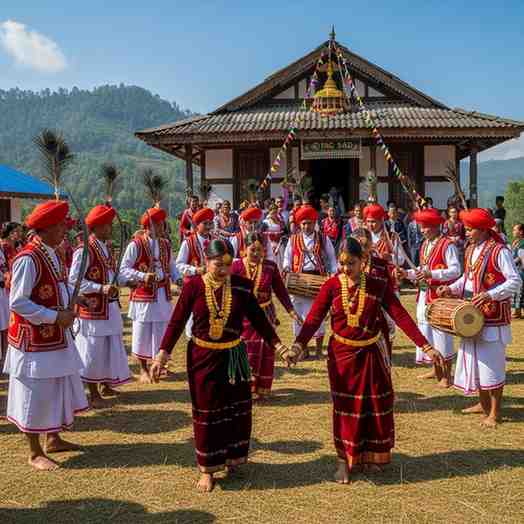
Context:
- The Khasi community of Meghalaya celebrated the Shad Nongkrem Festival at Smit , the traditional capital of Hima Khyrim , located about 20 km from Shillong. This five-day annual festival is among the most important cultural and religious events of the Khasi tribe, symbolising thanksgiving for a bountiful harvest, prosperity, and communal harmony .
Cultural and Religious Significance
-
The festival is held in honour of Ka Blei Synshar , the goddess of fertility and prosperity .
-
Rituals are conducted by the Syiem (King) of Hima Khyrim , currently Dr. Balajied Syiem , along with high priests.
-
The central Pomblang ceremony involves the offering of sacrifices to Lei Shyllong , the deity of Shillong Peak , seeking blessings for peace and abundance.
Traditional Dances and Attire
-
The highlight of Shad Nongkrem is its traditional dance performances :
-
‘Ka Shad Kynthei’ – performed by Khasi maidens symbolising purity and grace.
-
‘Ka Shad Mastieh’ – performed by men wielding swords and yak hair whisks, representing protection and valor.
-
Women wear crowns adorned with the rare golden ‘Tiew Lasubon’ flower , a mark of purity and sanctity.
-
The dances are accompanied by rhythmic drums and tangmuri (traditional pipes) , adding vibrancy to the celebration.
Community and Symbolism
The festival unites the Khasi people, celebrating the harmony between nature, divinity, and humanity . The umbrellas held over royal maidens during dances represent respect and spiritual protection . It reflects the matrilineal culture and deep ecological awareness of the Khasi tribe.
Exam-Oriented Facts
-
Festival Name: Shad Nongkrem (Nongkrem Dance Festival)
-
Duration: Five days
-
Location: Smit, Meghalaya (Hima Khyrim)
-
Deity Honoured: Ka Blei Synshar (Goddess of fertility)
-
Key Ritual: Pomblang ceremony
-
Key Dances: Ka Shad Kynthei (women), Ka Shad Mastieh (men)
-
Flower Used: Tiew Lasubon (golden flower)
-
Presiding Chief: Dr. Balajied Syiem, Syiem of Hima Khyrim
Month: Current Affairs - November 07, 2025
Category: Indian Culture / Festivals of Northeast India